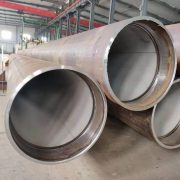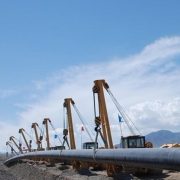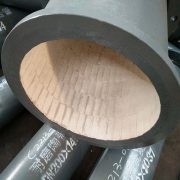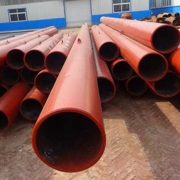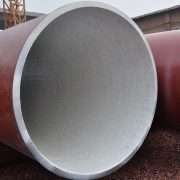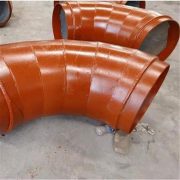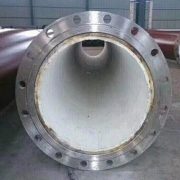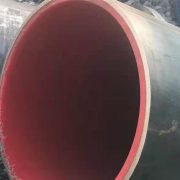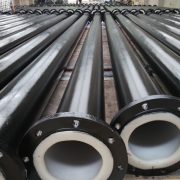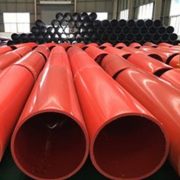What do you know about bimetallic pipes?
Introduction of Bimetal Wear-resistant Pipes
The bimetallic composite pipe is a new type of wear-resistant pipe developed by our company. The outer layer of the straight pipe is made of ordinary steel pipe, and the high chromium cast iron is formed through the casting process. The inner lining is compounded. The outer wall of the elbow adopts a hot simmering elbow, and the inner layer is cast with high chromium cast iron. Compared with the traditionally used wear-resistant alloy cast iron, wear-resistant alloy cast steel, steel-ceramic composite pipe and cast stone pipe, the pipeline has many advantages.
Production Process
In the production process of the bimetal wear-resistant pipeline, the straight pipe adopts casting technology. This technology is that the liquid wear-resistant metal material is fused to the surface of another metal to form a composite steel body after hot melting, achieving the purpose of true metallurgical bonding. The bonding layer The shear strength is higher than that of the body metal, which fully realizes the mechanical complementarity of the base layer and the wear-resistant layer; the elbow, tee, reducer and other pipe fittings adopt the lost foam vacuum suction casting compound process, which is advanced in technology and effectively solves the problem The problem of compounding, the elbow and various other special-shaped pipes can be integrated as a whole, without changing the flow trajectory of the material in the elbow, and greatly reducing the resistance of material transportation.
In the selection of material, the outer wall of the steel is made of carbon steel, which ensures that the wear-resistant tube has high mechanical strength and impact resistance; the wear-resistant layer of the lining is made of wear-resistant alloy steel series, which is mainly added with Cr-Ni-Mo -Cu-RE and other alloys, after quenching and tempering heat treatment process, make the alloy steel not only have strong wear resistance and corrosion resistance, but also have higher mechanical strength and impact resistance.
Features of bimetal wear-resistant pipe products
1. Good wear resistance, giving full play to the excellent wear resistance characteristics of high chromium casting (KMTBCr20Mo3CuRe). The wear layer is made of high complex alloy material. The macroscopic hardness can reach HRC55 or more. The structure contains a large amount of M7C3 type hard. Carbide, its micro-hardness is HV1500-1800, and its anti-abrasive and wear-resistance performance is more remarkable. .
2. High pressure bearing, suitable for any pressure level. The inner lining is tightly combined with the outer steel pipe. The special process is adopted to form a weld between the composite layers to ensure operational reliability.
3. Good resistance to mechanical shock, thermal shock, wear and corrosion, and high temperature resistance: Since the matrix is mainly composed of austenite and carbide, there is a large amount of Gr element in the solid solution, so it can be significant in corrosion or high temperature environments The bimetal wear-resistant elbow has good wear resistance, corrosion resistance and high temperature resistance.
4. Convenient installation and connection, flanges can be used, arbitrary cutting, welding, and good overall performance: The bimetal composite wear-resistant pipe adopts ordinary steel pipe outside and high-end wear-resistant alloy inside, which forms a better metallurgical combination at the same time , It also gives full play to the wear resistance and corrosion resistance of high complex alloys and the good mechanical strength and impact resistance of ordinary steel pipes. It solves the contradiction between weldability and wear resistance that are difficult to reconcile with a single material. Able to achieve the best fit.
Application scope of bimetal wear-resistant elbows and pipes:
1. Power industry: raw coal system silos, hoppers, hoppers, powder feeding pipelines,
2. Coal industry: heavy ore coal preparation pipelines in coal preparation plants, wet coal conveying systems, sediment backfilling in mining
3. Mining industry: mine filling, concentrate transportation, tailings transportation pipeline
4. Iron and steel industry: coke particle transportation pipeline, coal mill pipeline, separator, elbow, cone, separation baffle
5. Cement industry: coal powder transportation. Mineral powder transportation
6. Machinery industry: lining of equipment for pulverizing, dust removal and ash discharge systems of power plants, and lining of dust removal equipment in steel plants.
Decho is a professional supplier on bimetallic pipes. If you need any for your project , pls contact us by email [email protected]

